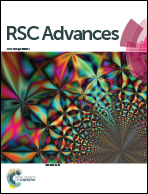Unusual thermal transport behavior in self-assembled fullerene nanorods†
Abstract
In this work, fullerene (C60) nanorods were prepared by a surfactant-assisted self-assembly method. Although the orientation of molecular alignment remains unchanged from one end to the other end in these C60 nanorods, they cannot be rigorously treated as single crystals because of the existence of amorphous-like regions formed by a high density of defects such as stacking faults and vacancy clusters. The partially crystalline and partially amorphous structure results in unusual thermal transport behavior in C60 nanorods, which cannot be classified into either typical crystalline-like or typical glass-like behavior. The thermal resistances of the C60 nanorods decrease with increasing temperature and reach a plateau around 100 K, which can be attributed to the combined effect of Einstein localized vibration in C60 molecules, intracluster vibration, and phonon-defect scattering. Accompanied with depositing Pt/C composites at two ends of a C60 nanorod to improve thermal contact between Pt electrodes and the C60 nanorod, tensile strain may be introduced in the C60 nanorod due to contraction, which enhances thermal resistance, especially in the low temperature range. Ultralow thermal conductivity (less than 0.06 W m−1 K−1) is observed for self-assembled C60 nanorods at room temperature, which is significantly lower than the thermal conductivity of bulk C60 single crystals and polycrystalline C60/C70 compacts but on the same order of magnitude as the lower limit of thermal conductivity of amorphous carbon.



 Please wait while we load your content...
Please wait while we load your content...